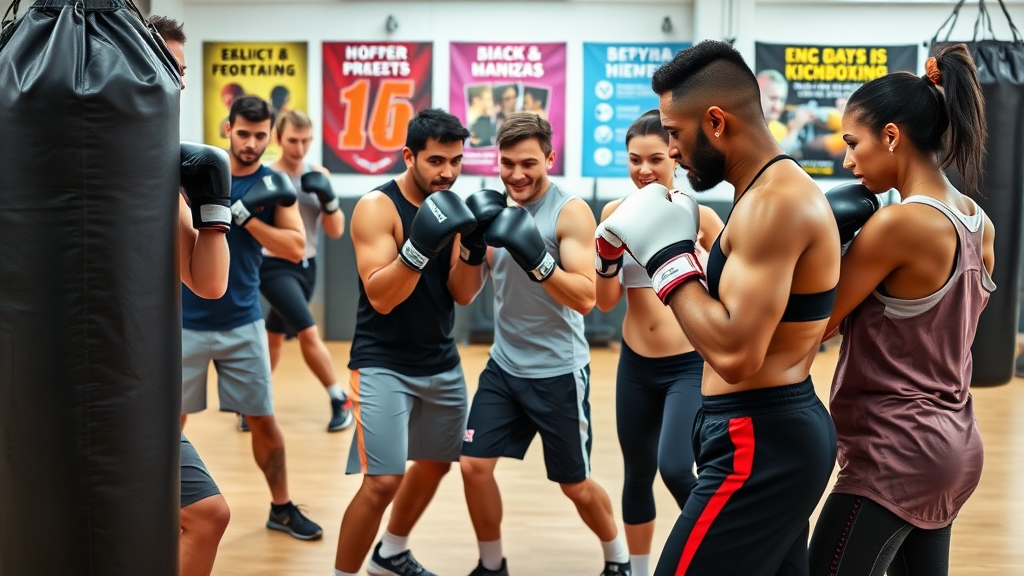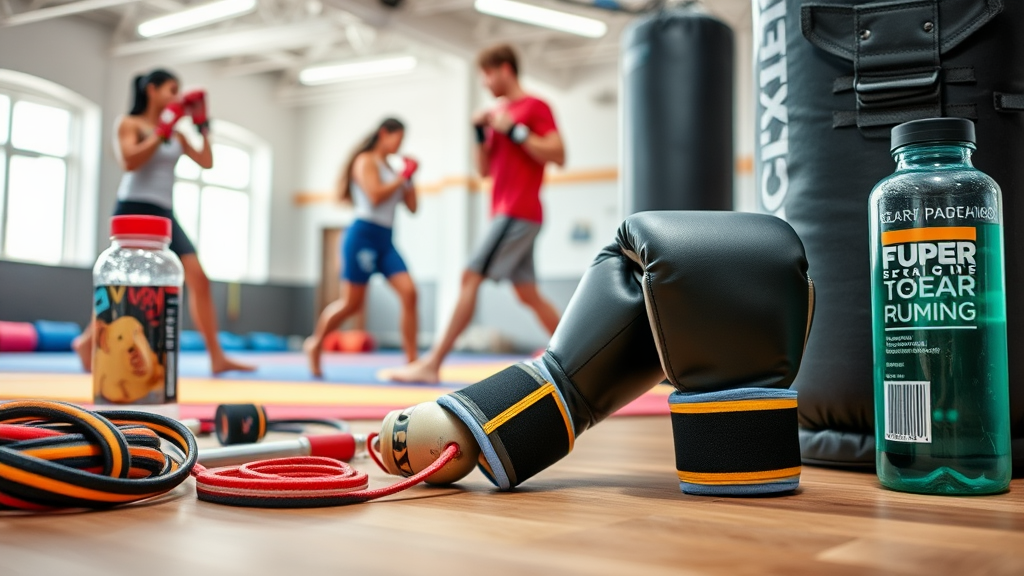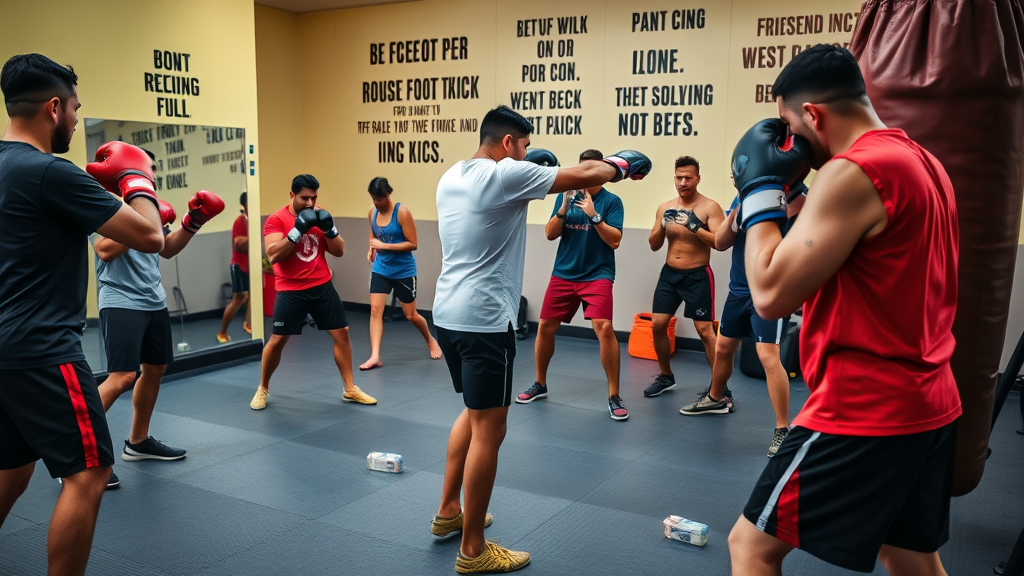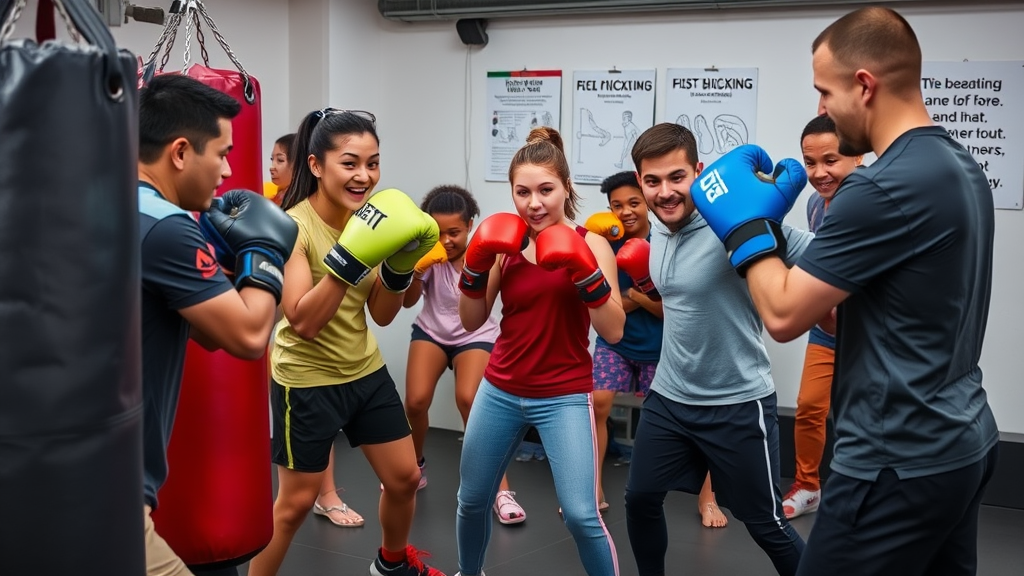Kickboxing is a fantastic way to get in shape, relieve stress, and learn self-defense. Whether you’re looking to improve your physical fitness or simply try something new, kickboxing offers a range of benefits that can cater to all levels of experience.
Key Takeaway

Kickboxing is an excellent sport for beginners interested in fitness, self-defense, and stress relief. It improves cardiovascular health, muscle tone, and mental well-being. Choose the right class, gear up properly, and start with the basics to make the most of your kickboxing experience.
Why Kickboxing is Perfect for Beginners

Kickboxing combines martial arts techniques with high-intensity cardio, making it an ideal workout for beginners. It doesn’t just improve your physical health; it also boosts mental resilience and discipline. Here are some key reasons why kickboxing is perfect for anyone new to the sport:
- Full-body workout: Kickboxing works all muscle groups, giving you a comprehensive workout without needing multiple exercises.
- Cardio and strength training: It combines the benefits of both cardio and strength training, enhancing both endurance and muscle strength.
- Stress relief: The act of kicking and punching can be a great way to release stress and pent-up energy.
- Self-defense skills: You’ll learn valuable techniques that can help you defend yourself in real-world situations.
- Mental toughness: Kickboxing requires focus and discipline, which can improve your mental toughness and resilience.
Getting Started: Finding the Right Kickboxing Class

Types of Kickboxing Classes
Kickboxing classes can vary widely in style and intensity. Here are some of the most common types you might encounter:
| Type of Class | Description |
|---|---|
| Cardio Kickboxing | Focuses on high-intensity cardio workouts without contact. Ideal for fitness enthusiasts. |
| Traditional Kickboxing | Combines elements of Muay Thai and Karate with full-contact training. |
| Self-Defense Kickboxing | Teaches practical self-defense techniques alongside fitness training. |
| Personal Training | One-on-one sessions tailored to your fitness goals and experience level. |
How to Choose the Right Class
When choosing a kickboxing class, consider the following factors:
- Instructor experience: Ensure your instructor has a strong background in martial arts and fitness.
- Class size: Smaller classes offer more personalized attention, which is beneficial for beginners.
- Class format: Decide whether you prefer full-contact training or a fitness-centered approach.
- Location and schedule: Choose a class that fits conveniently into your routine to maintain consistency.
Essential Gear for Kickboxing Beginners

What You Need
To get started in kickboxing, you’ll need some basic gear to ensure safety and comfort:
| Gear | Description |
|---|---|
| Gloves | Essential for protecting your hands during striking. |
| Hand Wraps | Provide additional wrist support and protection for your knuckles. |
| Shin Guards | Protect your shins during kicking drills. |
| Mouthguard | Important for protecting your teeth and mouth during sparring sessions. |
| Proper Attire | Wear comfortable, moisture-wicking clothing that allows full range of motion. |
| Water Bottle | Stay hydrated throughout your training sessions. |
Tips for Buying Gear
- Quality over cost: Investing in good quality gear will pay off in the long run.
- Fit and comfort: Ensure your gear fits well and is comfortable to wear during intense workouts.
- Ask for recommendations: Don’t hesitate to ask your instructor or fellow students for their gear recommendations.
Basic Kickboxing Techniques for Beginners

Essential Moves to Master
| Technique | Description |
|---|---|
| Jab | A quick, straight punch with your lead hand. |
| Cross | A powerful straight punch with your rear hand. |
| Hook | A punch thrown with a bent arm, aimed at the opponent’s side. |
| Uppercut | A punch delivered upwards, targeting the opponent’s chin. |
| Front Kick | A straightforward kick with the ball of your foot. |
| Roundhouse Kick | A high, swinging kick aimed at the opponent’s head or torso. |
Tips for Practicing Techniques
- Start slow: Focus on form and technique before increasing speed and power.
- Use a mirror: Practicing in front of a mirror can help you monitor and correct your form.
- Partner up: Working with a partner can provide valuable feedback and make training more interactive.
- Drill basics frequently: Regularly practicing basic moves will build a strong foundation for advanced techniques.
Building a Kickboxing Workout Routine

Sample Beginner Workout
Here’s a sample beginner kickboxing workout to get you started:
- Warm-up (10 minutes)
- Jump rope
- Dynamic stretches
- Technique Drills (20 minutes)
- Jab-cross combos
- Hook-uppercut combos
- Front kicks and roundhouse kicks
- Cardio (15 minutes)
- High knees
- Burpees
- Mountain climbers
- Cool Down (10 minutes)
- Static stretches
- Deep breathing exercises
Tips for Effective Workouts
- Consistency: Aim to train at least 2-3 times per week.
- Variety: Mix up your routine to include different techniques and exercises.
- Listen to your body: Rest when necessary to avoid injury and burnout.
Nutrition and Recovery

Eating Right for Kickboxing
Proper nutrition is crucial for kickboxers to maintain energy and support muscle recovery. Here are some nutritional tips:
- Balanced diet: Include a mix of protein, carbohydrates, and healthy fats.
- Hydration: Drink plenty of water throughout the day, especially before and after workouts.
- Pre-workout snacks: Eat a small snack with carbs and protein about 30-60 minutes before training.
- Post-workout meals: Consume a meal rich in protein and carbs within 2 hours of training for optimal recovery.
Recovery Tips
Effective recovery is essential for continuous improvement and avoiding injuries:
- Stretching: Incorporate both dynamic and static stretches into your routine.
- Rest days: Allow your body time to recover by taking rest days.
- Sleep: Aim for 7-9 hours of quality sleep per night.
- Massage and foam rolling: Use these techniques to release muscle tension and improve flexibility.
Real-Life Experiences

Testimonials from Our Students
At Thrive7 Martial Arts, we’ve seen numerous beginners transform their lives through kickboxing. Here are some real-life experiences from our students:
- Palacios Family: “Thrive7 has been an amazing experience for our little one! Her confidence level has skyrocketed, and the skills she’s learned so far have helped her with other sports she’s participated in. The environment is wonderful, and everyone is very welcoming. The master and other instructors are great leaders! Very happy being part of the Thrive7 Taekwondo team.”
Common Challenges and How to Overcome Them
| Challenge | Solution |
|---|---|
| Intimidation | Remember that everyone starts as a beginner. Focus on your progress, not others. |
| Soreness | Incorporate gentle stretching and adequate rest into your routine. |
| Plateaus | Mix up your workouts and try new techniques to keep things exciting. |
| Time Management | Schedule your workouts in advance and treat them as important appointments. |
Frequently Asked Questions
Is Kickboxing Safe for Beginners?
Yes, kickboxing is safe for beginners as long as you follow proper techniques and use the appropriate gear. Starting with a qualified instructor is essential to learn the basics correctly and minimize the risk of injury.
How Long Will It Take to See Results?
Results vary depending on individual effort and consistency. However, many beginners start to see improvements in their fitness levels and skills within a few weeks of regular training.
Do I Need Prior Experience in Martial Arts?
No prior experience is necessary to start kickboxing. Classes are designed to accommodate all skill levels, including complete beginners.
How Can I Stay Motivated?
Setting goals, tracking your progress, and finding a supportive community can help keep you motivated. Enjoying the process and celebrating small victories along the way can also boost your enthusiasm.
- According to Verywell Fit, focusing on the basics is crucial for kickboxing beginners. Learning the proper techniques for punches, kicks, and footwork is essential for building a strong foundation.
- Another effective strategy for kickboxing beginners is practicing regularly. Healthline suggests aiming for at least two to three classes per week to see improvements in fitness and technique.
- Proper conditioning is also important for kickboxing beginners. Active recommends incorporating exercises such as jumping jacks, burpees, and mountain climbers into your routine to improve agility, endurance, and power.
- Additionally, LiveStrong suggests finding a good instructor or training partner to help you learn the ropes. A knowledgeable instructor can provide valuable feedback and help you avoid common mistakes.
- Lastly, Self recommends starting with low-impact moves and gradually increasing intensity as you become more comfortable with the techniques. This approach can help prevent injuries and allow you to build up your strength and endurance over time.
Conclusion
Kickboxing is an excellent sport for beginners looking to improve their fitness, learn self-defense, and reduce stress. By choosing the right class, gearing up properly, and practicing basic techniques, you’ll be well on your way to mastering this exciting martial art. Join us at Thrive7 Martial Arts and start your kickboxing journey today!
By integrating fitness, self-defense, and mental discipline, kickboxing offers a balanced and rewarding experience for beginners. Ready to get started? Visit us at Thrive7 Martial Arts and take the first step towards a healthier, stronger you.
For more information, contact us at:
- Phone: 714-237-9988
- Email: info@thrive7martialarts.com
- Address: 1876 N Placentia Ave, Placentia CA 92870
Stay connected with us on social media for the latest updates and tips.

